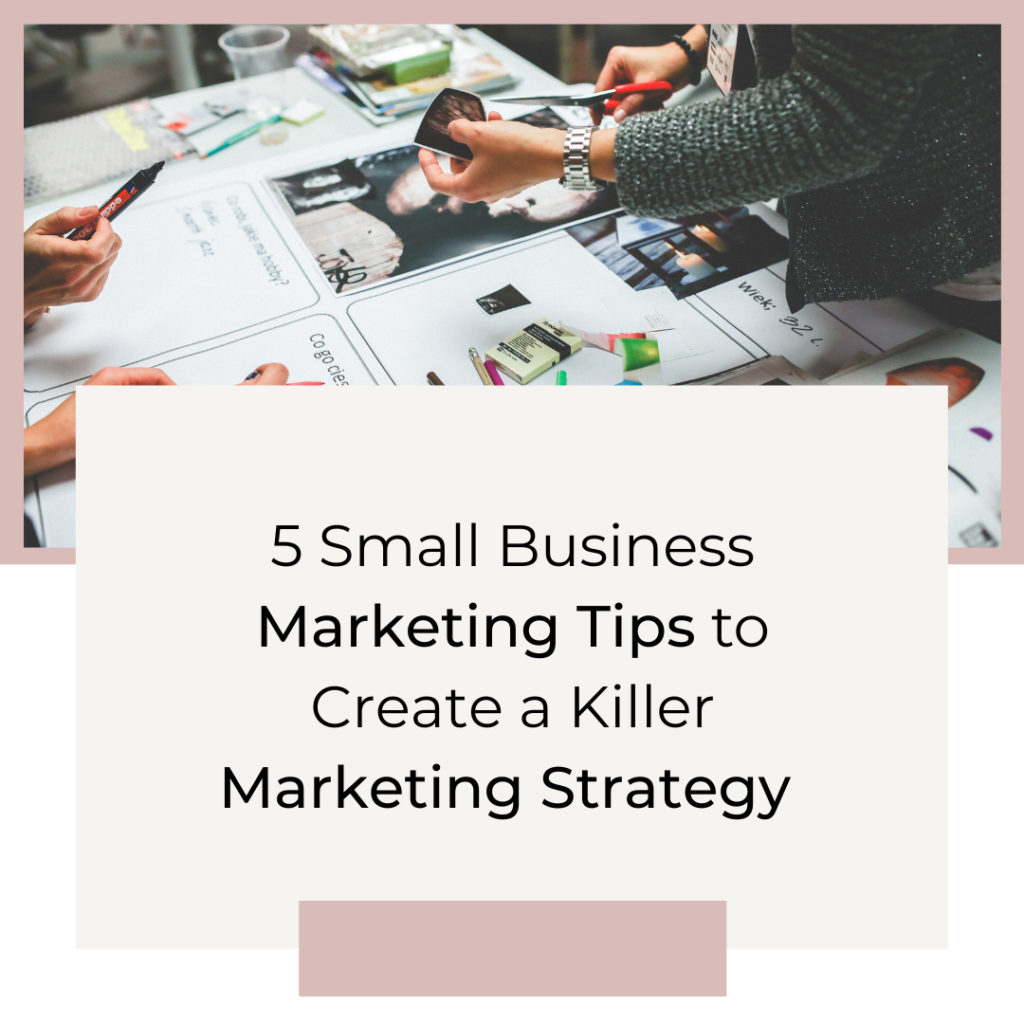5 Small Business Marketing Tips to Create a Killer Marketing Strategy

This post uses affiliate links.
Looking for the best small business marketing tips to
accelerate your business growth? With the 5 small business marketing tips in
this article you will learn everything you need to know to start marketing your
small business.
How do you navigate the world of marketing as a small business? How can you compete with the conglomerates spending millions, if not billions, of dollars on marketing out there?
The answer is you can’t. But with the right marketing, you don’t have to.
The marketing that works best for small businesses is often social media and content marketing. But it all depends on what your business offer and who your customer is.
That is why it is important to create a marketing strategy for your small business. And that starts with learning the foundations of marketing with these 5 small business marketing tips:
- Learn your marketing basics
- Marketing to achieve business goals
- Meeting customer needs
- Being better than the competition
- Communicating your position
Small business marketing tip no 1: Learn your marketing basics
If you do not have any previous experience or education in marketing, starting out can seem intimidating and difficult. Marketing is a huge field, so it can be challenging to understand where to start. When most of the marketing out there seems to involve spending huge amounts of money on advertising, doing marketing for small businesses can be tough. But the best way to get started is to learn your marketing basics.
What is marketing?
The first thing you need to understand, and the most common misconception, about marketing is that marketing is not advertising. While all advertising is part of marketing, all marketing is not advertising. Marketing is basically the outbound strategy your business has. The most common and the easiest way to describe marketing is with the marketing mix; the 4 P’s. This is the most classic marketing model and might seem old and outdated. But it’s the most used one for a reason; it is easy to understand.
The 4 P’s are:
- Product; the product or service you are offering to satisfy the customers’ needs.
- Price; pretty much says itself, it is the price of your product.
- Promotion; this involves how you sell your product, and yes that is where advertising comes in.
- Place; where you sell your products. It is the physical location or online store where the customer buys the product but also all you communications channels.
There is much more to these 4 P’s but this should give you a basic idea of all that marketing involves.
Do I need marketing as a small business?
Yes. All businesses need marketing. Like you just learned above marketing is everything that has to do with your product, pricing, promotion and place. Even if you are not actively using marketing techniques, if you have a product for sale for a set price, you have done some marketing.
Of course marketing practices involves more than that; it is about how to be strategic with these four factors to grow your business. One way to describe the purpose of marketing is:
To achieve the business’s goals by meeting and exceeding customer needs and expectations, better than the competition.
What this means specifically for you as a small business we will break down in the following steps.
Small Business Marketing Tip no 2: Marketing to achieve business goals
The second small business marketing tip concerns the first part of our marketing statement; achieving business goals. The purpose of marketing is to achieve the business goals and in order to do that, you need to create a marketing plan.
Before you exit this article thinking ‘a marketing plan sounds too difficult’, let me tell you it does not need to be. For a small business a marketing plan does not need to be a 60 page long document.
It is enough to answer the following four questions, in a slightly structured way:
- Where are we now?
- Where do we want to be?
- How do we get there?
Where are we now?
Answering this question helps you better understand what the business’s current situation is. In order to go somewhere, you first need to know where you are.
The easiest way to do this is to think in the terms of your business’s strengths, weaknesses, opportunities and threats. Or in other words perform a SWOT analysis. The strengths and weaknesses regards the internal abilities of your business. Whereas the opportunities and threats are external factors that concerns the market your business operates in.

Where do we want to be?
This is one of the most important questions to consider when creating a marketing plan. The answer to this question will determine your entire marketing strategy. It is in this stage you set a vision for your business and determine marketing objectives.
If you have set up overall business goals, it will be easier to answer this question. But first you need to understand the difference between business and marketing goals. Business goals are usually set in financial terms, such as increases in revenue, profits and ROI. The marketing goals are subordinate to the business goals, which means they are set to achieve the business goals. That means, if the business goal is to grown revenue with 50 percent in the next 5 years. The marketing goals could be to expand to new locations, grow the customer base or increase current customer spending.
For a small business, marketing objectives usually entail increasing the customer base in one way or another. As a small business, you are usually not very well-known and want to increase awareness.
Before you set the marketing objectives it is important that you have a clear vision for your business. A vision is a short statement of what the business wants to achieve in the future. Your vision is about why you started the business and what your ultimate dream of the business is. The vision does not need to be actionable but it should be possible. A simple vision could be ‘To bring the world happiness’. It is not directly actionable but it is possible to bring happiness by selling a product that makes people happy.
The vision, in combination with your business goals, should then serve as the foundation of your marketing objectives. To set clear marketing objectives, a good idea is to think in terms of 1, 5 and 10 years. And then answer the question of where you want the business to be in each of those timelines.
How do we get there?
What steps to you need to take to the 1-year, 5-year and 10-year marketing objectives?
This step is where you make the marketing objectives actionable by determining how to meet and exceed customer needs better than the competition. Which brings us to the next small business marketing tip.
Small Business Marketing Tip no 3: Meeting customer needs
To be able to meet your customer’s needs you have to know your customer – and understand what they need. That means defining your target audience and getting to know them.
Let us dive into the third small business marketing tip regarding meeting customer needs.
Who is your customer?
It is vital to know who your customer is to target their needs with your marketing. Everyone has different preferences, interests and backgrounds. This means that your product will not appeal to everyone. That is why you need to perform target marketing and select a specific target audience, whose needs you will satisfy with your offer. Selecting a specific narrow target audience is especially important as a small business. Because you don’t have the resources to compete with large corporations. Offering a product specialized to a specific target audience, will ensure that you don’t have to compete with the big companies.
To perform target marketing you need to segment different customers. You do this by identifying differences between groups of consumers. The most common way to separate groups are by demographic, psychographic and behavioral variables. As part of your target marketing you need to understand who the target audience is as well. What are their problems, interests and desires? Learn more about how to target and get to know the right audience in this article about target market analysis for small businesses.
How does the customer buy?
Understanding your customer’s needs means to understand how they perform their purchases. Learning basic consumer behavior will help you create better marketing strategies. And grow your business. Consumer behavior is a complicated topic. But I will outline the most significant parts. Understanding how your customers make the decision of what products to buy, will give you an advantage over most small businesses.
The process starts when a customer discovers a need; either a desire for something or a problem they need solved. Then the customer starts looking for something that can satisfy that need – usually a product or service. The customer gets exposed to several alternative solutions that can solve the need. And they have to choose between these different alternatives. The customer decides which alternative they like the most and buys it.
So how does this apply to your small business? You have to identify the need your product aims to satisfy. First of all, you need to ensure that your product satisfies a desire or problem your target audience has. Then your product has to be in the right place, where the target audience discovers that need. Or you need to evoke the need through communication. After that you need to make sure that your alternative is the best choice for your target audience.
If this sounds complicated, don’t worry, this aims to make you aware of the process so you can ask the right questions. If you want to learn more about consumer behavior check out this article on the consumer decision making process.
How does the customer choose?
Now you should have defined your target audience and have somewhat of an understanding of the buying process. We will dive into the different marketing aspects you need to have in place to satisfy the customers need when they are making their choice.
There are five criteria you should think about when marketing your business to help the customer choose your product. Thinking about these criteria will help you develop an offer that your customer will choose.
- Technical criteria such as quality, features and credibility. Think about the technical characteristics that makes your product or service unique and appeals to your target audience.
- Economic criteria involves the price of the product and value for money. How does your target audience value money and what are their financial abilities?
- Social criteria means how the product affects how other people view them. How does your target audience think about status and how does this relate to your offer?
- Personal criteria relates to the customers personal thoughts, views and self-image. How does your offer relate and impact to the customers views of themselves and the world?
- Emotional criteria are the emotions tied to your business or offer. Which emotions are your offer evoking in the customer? What emotions are your target group looking to please with your product?
These are the different aspects that will impact the customer’s choice. By thinking in these terms you can adapt your business offer to better satisfy the needs of your target customer.
Where does the customer buy?
This question concerns where your target audience buys and what communication mediums you should use. If you remember the first small business marketing tip and the 4 P’s – this question regards ‘Place’.
Where customers make purchases and where you can communicate with them, varies depending on your target audience. An example is social media platforms. These are great to target small audiences because it is easy to tailor ads and content to a specific group of people. You still need to find out if your target audience actually uses social media. Most people, even older generations, have social media nowadays. But they might not be very active or willing to make purchases on social media. If your target audience consists of seniors, there are better places you can be to reach them. If you do want learn if you should use social media to target your customers, read this article about Social Media Marketing for Small Businesses.
It is important to understand where your target audience spends their time. Make sure to do some research and look into where what channels and mediums your target audience use.
To recap a little, you have to make sure that your business satisfies the needs of your customers. And to do that you need to know who your target audience is, where they are as well as how they buy and make decisions. Knowing this will ensure that your product or service will meet the needs of the customer.
Small Business Marketing Tip no 4: Being better than the competition
The fourth small business marketing tip regards the competition. Now that you know how to meet your customers’ needs, you have to do it better than your competitors. Standing out from the competition as a small brand is not easy, especially with the entire internet being full of options. The first step to beat the competition is to identify them.
Identify your competition
Even if you have selected a very small target audience and your product satisfies their needs perfectly, there are still competitors out there. You are competing with both large corporations and other small businesses like yours. They might not offer the exact same product as you. But the customer considers them similar enough to be an alternative solution to the same problem. That is why you need to identify your competitors to convince the customer that you are better than them.
If you do not know who your competitors are, put yourself in the shoes of your customer. Do the research you would do, if you were looking for a solution to the need your products aim to satisfying. Identify three to five of the most significant competitors and then answer the following questions:
- What is their Unique Selling Point (i.e. their unique offer)?
- Who is their target audience?
- What are their strengths?
- What are their weaknesses?
- Where are they communicating with the target audience?
You don’t necessarily need to write down everything about the competition in a formal document but take some brief notes that you can work with.
Differentiate your business
After identifying the competition you should have a solid idea of what your competitors offer. Now you have to differentiate your business offer, in the minds of your target customers. This is done through positioning your business in relation to your competition.
Positioning means the place that your brand occupies in the minds of the customers. And how it is different from the way customers view your competitors. When you know what your competitors’ positions on the market are, it is time to develop your own brand positioning strategy.
Start by looking at the answers to the questions in the previous section. Think about how your business is different. You can also use your SWOT analysis and compare to the competition. Then identify positions on the market that differentiates you from the competition.
Consider the following four elements before you decide on a definite position:
- Clarity which means that your positioning idea needs to be clear and concise. Both your choice of target audience and your competitive advantage.
- Credibility, which refers to your position being credible in the mind of the consumer. For example, if you as a small business sell purses it is not credible to position your brand next to Hermès. If you want to be in the luxury hand bag business, it makes more sense to position your brand in the lower end of the premium price range. As hand-crafted, quality purses rather than a luxury brand name.
- Competitiveness means that your position and differentiated offer needs to be competitive. It needs to offer something that the competition cannot.
- Consistency refers to your communications. You need to be consistent with your position in all communications with your target audience. We will delve further into this subject in small business marketing tip 5.
Thinking in these four terms will help you develop a positioning strategy that is solid and grows your business.
Positioning through branding
To establish a unique position on the market that your competitors cannot copy – you need to build a brand. A brand adds value by creating unique distinguishable values, associations and characteristics. Creating a brand that connects with your personal values will help your business build a differentiated position. To learn more about the branding process, read this article on How to Build a Brand as a Small Business.
Small Business Marketing Tip no 5: Communicating your position
The fifth and final small business marketing tip regards your communication. Market communications is the primary resource businesses have to compete for customers. It is vital that you communicate your business’ chosen position to your target audience. The communications is what creates the additional value of your brand. It also separates your business from the competitions, in the mind of the customers.
This step is where we tie together the full marketing strategy that we created in the previous steps. The communications start with your marketing objectives. Based on these, your communication must reflect your target audiences’ needs and your brand’s benefits
Create content not promotions
To build your brand position you need to create content and not promotions in your communications. Content involves creating communications that have editorial qualities. It creates interest and curiosity on a deeper level. The purpose of content is to create liking and clarity of what your brand represents. Not to generate sales. This type of content, as opposed to promotional content, creates value for the long term.
Content can be of educational, entertaining or inspirational character. It aims to make the customer want to consume your communications. When creating communications for your target audience, think about what their interests and needs are. What type of content could make them connect with your business?
f you are not great with graphic design or copy writing consider getting help from a professional that can create your posts for you. It will save you both time and effort. And it does not need to cost a fortune. There are plenty of services out there, like Fiverr, where you can hire freelancing professionals for a great price. On Fiverr you can find graphic designers to help you with your social media content so you don’t need to worry about it.
Communicate where your audience is
It is vital that you choose the right communication medium for your target audience. This relates back to the section about ‘Place’ and where your customer buys. Create content and communicate your brand on the platforms that your target audience spends time.
Consistency is key
‘Consistency is key’ is a phrase you will hear across all forms of marketing. It is especially important in the communication of your brand position. All your communication, no matter format or medium, need to be consistent with your positioning. It involves always using your brand when creating content. Before you publish your content, think about how it helps instill your position and brand in the mind of your target customer.
With these five small business marketing tips you should have found everything you need to know to start marketing your business. Now you know the basics of marketing. And can put them to use when setting goals, meeting customer needs, beating the competition and in your communications. I hope these small business marketing tips will help you grow your business and achieve your goals!

I'm Emma Ellinor
I’m a digital marketer, project manager and retail analyst.
For the past 7 years I have immersed myself into the field of marketing and management. I am on a mission to inspire more women to take their business to the next level. By sharing my journey to escape the 9-5 trap along with useful marketing, time management and small business tips.
